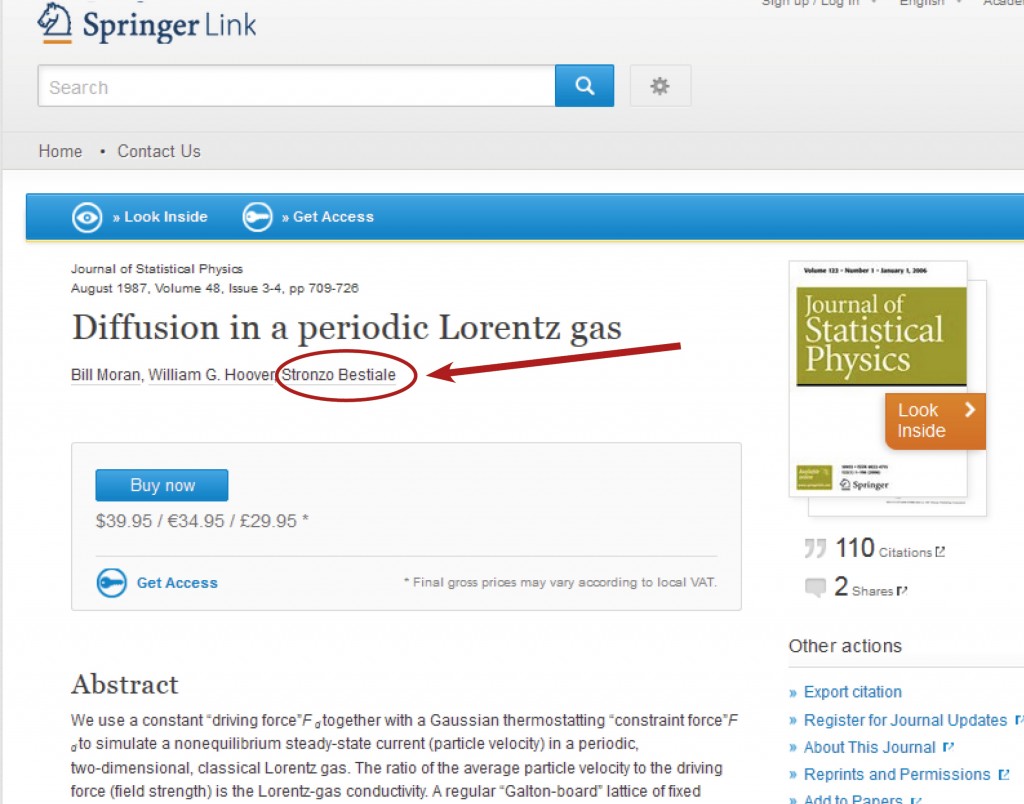 Would you read a paper written by Stronzo Bestiale (Total Asshole)? A dose of mistrust would be justified: the name says it all. Yet, in 1987, professor Bestiale, supposedly a physicist in Palermo, Sicily, authored major papers in prestigious scientific peer reviewed journals such as the Journal of Statistical Physics, the Journal of Chemical Physics and the proceedings of a meeting of American Physical Society in Monterey.
Would you read a paper written by Stronzo Bestiale (Total Asshole)? A dose of mistrust would be justified: the name says it all. Yet, in 1987, professor Bestiale, supposedly a physicist in Palermo, Sicily, authored major papers in prestigious scientific peer reviewed journals such as the Journal of Statistical Physics, the Journal of Chemical Physics and the proceedings of a meeting of American Physical Society in Monterey.
Given that surnames always intrigued me (they are the subject of my first book), I tried to find this person in Italian telephone directories. In Italy there are 7 Bestiale, mostly in Piedmont. None of them, however, has the name Stronzo (Turd or a Asshole: who would call their own son that?); between the Veneto and Trentino-Alto Adige there are 4 Stronziero, but this is also a surname.
In fact, Stronzo Bestiale does not exist as confirmed, when those scientific papers were published 27 years ago, by the then Chancellor of the University of Palermo, Ignazio Melisenda Giambertoni (another unusual surname!).
So I decided to investigate more thoroughly. The self-styled Bestiale appears in the papers authored by Bill Moran and William G. Hoover, two influential American scientists from the Lawrence Livermore National Laboratory. In particular, Bestiale appears in various documents authored by Hoover, who also cited him at the end of a very serious physicspaper, saying that “discussions with him were very useful.”
I wrote an email to professor Hoover, now retired, to ask him the true story of Stronzo Bestiale. Here’s what he answered.
«At that time, the period 1984-1987» he says «we were very active in the development of a new computational technique, non-equilibrium molecular dynamics, connecting fractal geometry, irreversibility and the second law of thermodynamics. The idea was born during meetings at CECAM (Centre Européen de Calcul Atomique et Moléculaire) in Lausanne, Switzerland, and the Enrico Fermi summer school organized at Lake Como with Giovanni Ciccotti, professor of condensed matter physics at the University La Sapienza University in Rome. In these meetings, the theoretical picture of this technique was clear to me, so I wrote several papers on the subject along with some colleagues». But the reviewers of Physical Review Letters and the Journal of Statistical Physics refused to publish his texts: they contained too innovative ideas.
This is nothing new: new discoveries in science are hard to publish because scientists are rather conservative, as discussed by the epistemologist Thomas Kuhn. Meanwhile, Hoover continues, «while I was traveling on a flight to Paris, next to me were two Italian women who spoke among themselves, saying continually: “Che stronzo (what an asshole)!”, or “Stronzo bestiale (total asshole)”. Those phrases had stuck in my mind. So, during a CECAM meeting, I asked Ciccotti what they meant. When he explained it to me, I thought that Stronzo Bestiale would have been the perfect co-author for a rejected publication». So he decided to submit his papers again, simply by changing the title and adding the name of that author. And the researches were published.
In short, a pointed joke. Not everyone took it well, at the time: the President of the Italian Physical Society, Professor Renato Angelo Ricci said, «This joke is an offense to the entire Italian scientific community». After receiving several calls in the editorial office from Italian readers asking for explanations about that vulgar author, the editor of the “Journal of statistical physics”, Joel Lebowitz, published a letter of apology in the March 1988 issue: “It has come to my attention that the name given as the third author in the above paper is in fact a rather obscene expression in Italian. I apologize to the readers for not catching this stupidity of the other two authors. ”. The rectification, as often happens, went unnoticed.
Inreality, though,
this joke laid bare how vulnerable control systems in the review of scientific research were (and still are!) . If you are able to insert in a publication the name of a nonexistent author in a publication, who will guarantee that even the scientific contents have been examined with care? Incredibly, even today, 27 years later, Stronzo Bestiale continues to be present as the author of publications in scientific databases: is it not extraordinary?
I asked one of the authors, Ward C. Wheeler, of the division of invertebrate zoology at the American Museum of Natural History for clarification. And he revealed that they knew very well the meaning of “merda” from Catalan: not Italian, but it makes no difference … «We chose that acronym on purpose, to highlight the poor quality of incomplete groups of data. It was a amusing acronym. The procedure, which in the meantime has been further developed, it is still used for the analysis of incomplete fossils samples». 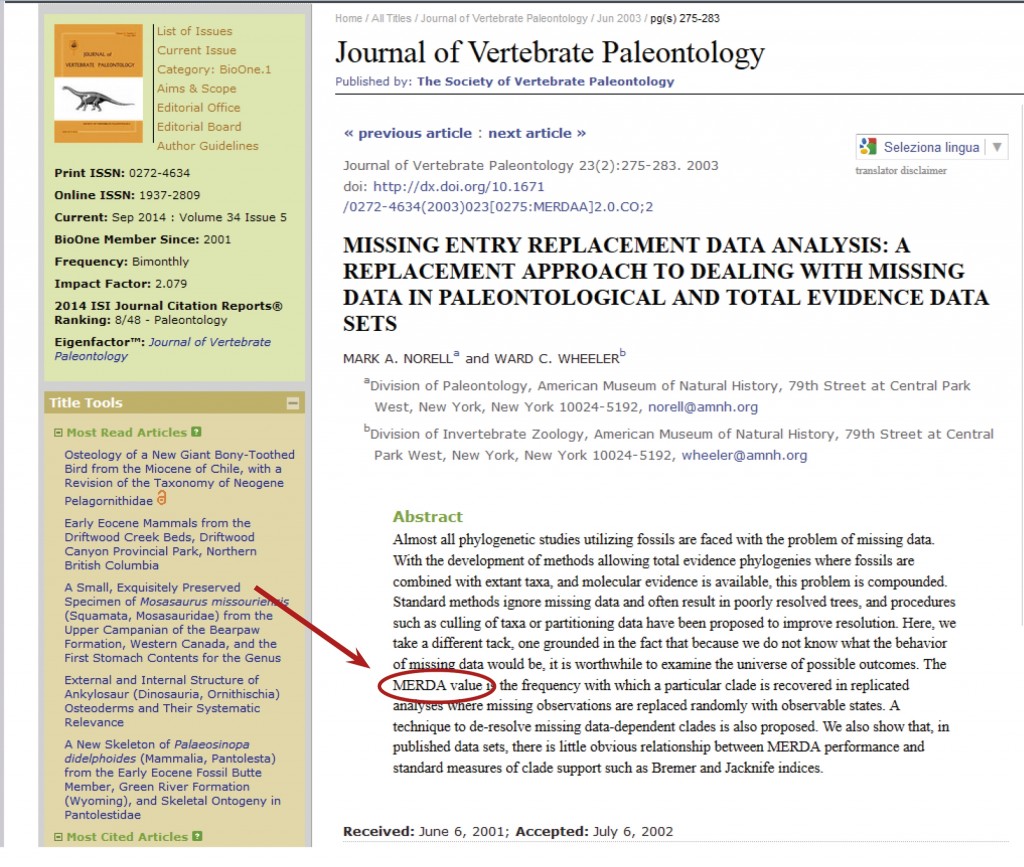 But Stronzo Bestiale is not the only dirty word published in international scientific journals. More recently, in 2003, the Journal of Vertebrate Paleontology published a study on the “MERDA (shit) value”, which stands for Missing Entry Replacement Data Analysis, a technique for phylogenetic reconstruction in paleontology.
But Stronzo Bestiale is not the only dirty word published in international scientific journals. More recently, in 2003, the Journal of Vertebrate Paleontology published a study on the “MERDA (shit) value”, which stands for Missing Entry Replacement Data Analysis, a technique for phylogenetic reconstruction in paleontology.
Was this an embarrassing coincidence that the authors realized only after the fact? Far from it!
So, scientists do have sense of humor. Fortunately. As for people with vulgar surnames … they do exist. In Italy there are thousands. I will tell their stories in the next post. [click here for italian version ]
UPDATE #1: my collegue Fabio Turone, president of SWIM (Science Writers in Italy, an association of science journalists) sent me the profile of Stronzo Bestiale from Scopus, an international bibliographic and bibliometric database (see screenshot below). In Scopus, professor Stronzo Bestiale appears to be working at the Institute of Experimental Physics, at the University of Vienna, the institutional affiliation attributed to him in the paper published by the Journal of chemical physics. One more point on his résumé!
UPDATE #2: italian research also has had a funny episode with dirty words. Some readers of this blog report a Prin (Research project of relevant national interest), presented in 2011 by researchers from INFN and University of Torino. It was a virtual analysis system for the LHC particle accelerator at CERN in Geneva. The acronym of the system was Vaffa (an abbreviation of vaffanculo, fuck off): Virtual Analysis Facility For the Alice experiment. The project, which you can read about here, was not approved.
 UPDATE #3: a reader of this blog, Ugo Finardi, points out antenna FICA (acronym of Folded Inverted Conformal Antenna): in italian, FICA means cunt. It’s not a coincidence, because this antenna was invented by an Italian couple of engineers who, at the time, worked in the research laboratories of Motorola in the United States, Carlo Di Nallo and Antonio Faraone. The invention has been presented in 2005 at the international symposium of the IEEE (Institute of Electrical and Electronic Engineers).
UPDATE #3: a reader of this blog, Ugo Finardi, points out antenna FICA (acronym of Folded Inverted Conformal Antenna): in italian, FICA means cunt. It’s not a coincidence, because this antenna was invented by an Italian couple of engineers who, at the time, worked in the research laboratories of Motorola in the United States, Carlo Di Nallo and Antonio Faraone. The invention has been presented in 2005 at the international symposium of the IEEE (Institute of Electrical and Electronic Engineers).
UPDATE #4: the funny story of Stronzo Bestiale had an international resonance. It’s cited by american blog RetractionWatch, an observatory of retractions and corrections in scientific papers, edited by Ivan Oransky, professor of medicine at New York University School of Medicine and editorial director of MedPage Today. Oransky recalls a similar case: the immunologist Polly Matzinger, who in 1978 published a study co-authored by entering Galadriel Mirkwood: the name of her afghan hound. It was a way to protest against the use of passive voice in scientific papers (“it was discovered that …”).
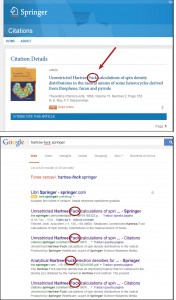 UPDATE #5: the Hartree-Fock method is a procedure in computational physics, which is used to simulate quantum systems. It is named by its discoverers Douglas Hartree and Vladimir Fock. The latter is a Russian physicist with a surname that, in English, is likely to be crippled so vulgar (fuck). And in fact, their method – at a distance of 46 years after the paper that this discovery – has become Hartree-Fuck in Springer publisher’s website (click image to enlarge). And if you type in Google “Hartree-Fuck Springer”, you will get different results mentioning Fuck in the title. Difficult to determine whether it was a mistake or a joke. Or a way to get more clicks on the Web (even by those who make mistakes typing the name)?
UPDATE #5: the Hartree-Fock method is a procedure in computational physics, which is used to simulate quantum systems. It is named by its discoverers Douglas Hartree and Vladimir Fock. The latter is a Russian physicist with a surname that, in English, is likely to be crippled so vulgar (fuck). And in fact, their method – at a distance of 46 years after the paper that this discovery – has become Hartree-Fuck in Springer publisher’s website (click image to enlarge). And if you type in Google “Hartree-Fuck Springer”, you will get different results mentioning Fuck in the title. Difficult to determine whether it was a mistake or a joke. Or a way to get more clicks on the Web (even by those who make mistakes typing the name)?
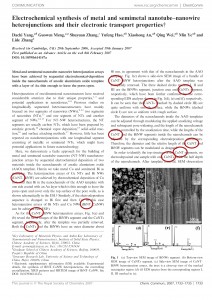 UPDATE #6: a reader of this blog, Andrew White, points out two other vulgar acronyms, contained in a 2007 survey on the electrochemical synthesis of nanotubes: BINT (Bismuth nanotubes, nanorods of bismuth) and CUNT (Cu stands for copper: click image to enlarge). Since this is a research written by Chinese authors, it was almost certainly an accident. But it seems that among chemists had a considerable popularity.
UPDATE #6: a reader of this blog, Andrew White, points out two other vulgar acronyms, contained in a 2007 survey on the electrochemical synthesis of nanotubes: BINT (Bismuth nanotubes, nanorods of bismuth) and CUNT (Cu stands for copper: click image to enlarge). Since this is a research written by Chinese authors, it was almost certainly an accident. But it seems that among chemists had a considerable popularity.
UPDATE #7: professor Mark Liberman, linguist at Pennsylvania University, points out many papers signed Connard (in French, connard means shithead). I checked if one of the most prolific authors, a geologist from Oregon, Gerald G. Connard, really exists: in telephone directories he is present, and probably others. Moreover, people with a vulgar surname are many: among them there must be some scientist!
 UPDATE #8: this morning I discovered that a Us company, Albany Retro Snarky T-Shirts, created a T-shirt about this story, with the inscription “I’m friends with Stronzo Bestiale“. The catch-phrase: “The super funny T-shirt for any scientist!”. Perhaps professor Hoover and me should ask the royalties on this business… 🙂
UPDATE #8: this morning I discovered that a Us company, Albany Retro Snarky T-Shirts, created a T-shirt about this story, with the inscription “I’m friends with Stronzo Bestiale“. The catch-phrase: “The super funny T-shirt for any scientist!”. Perhaps professor Hoover and me should ask the royalties on this business… 🙂
UPDATE #9: the Improbable Research organization has re-launched on its website the Stronzo Bestiale story (under “improbable investigators”). Maybe one day prof. Bestiale could win an IgNobel: after a so long carrer, he’d deserve it! Do we candidate him?
 UPDATE #9: Stronzo Bestiale’s story has been reported on Science website.
UPDATE #9: Stronzo Bestiale’s story has been reported on Science website.
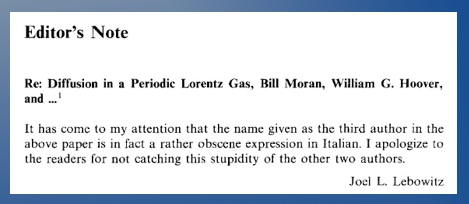 UPDATE #10: also “Scientific american” website tells the Stronzo Bestiale story for the april fool day. The author, Philip Yam, also found a backstory: after the article by Hoover was published, the production editor of the Journal of Statistical Physics, Jim Langlois, received a call from an italian journalist, who asked explanations for this unusual author. And he also explained the meaning of “stronzo bestiale” in Italian. So the joke came to light: in the next issue, the editor Joel Lebowitz wrote an article of apology: “It has come to my attention that the name given as the third author in the paper is a rather obscene expression in Italian. I apologize to the readers for not catching this stupidiy of the other two authors. “
UPDATE #10: also “Scientific american” website tells the Stronzo Bestiale story for the april fool day. The author, Philip Yam, also found a backstory: after the article by Hoover was published, the production editor of the Journal of Statistical Physics, Jim Langlois, received a call from an italian journalist, who asked explanations for this unusual author. And he also explained the meaning of “stronzo bestiale” in Italian. So the joke came to light: in the next issue, the editor Joel Lebowitz wrote an article of apology: “It has come to my attention that the name given as the third author in the paper is a rather obscene expression in Italian. I apologize to the readers for not catching this stupidiy of the other two authors. “
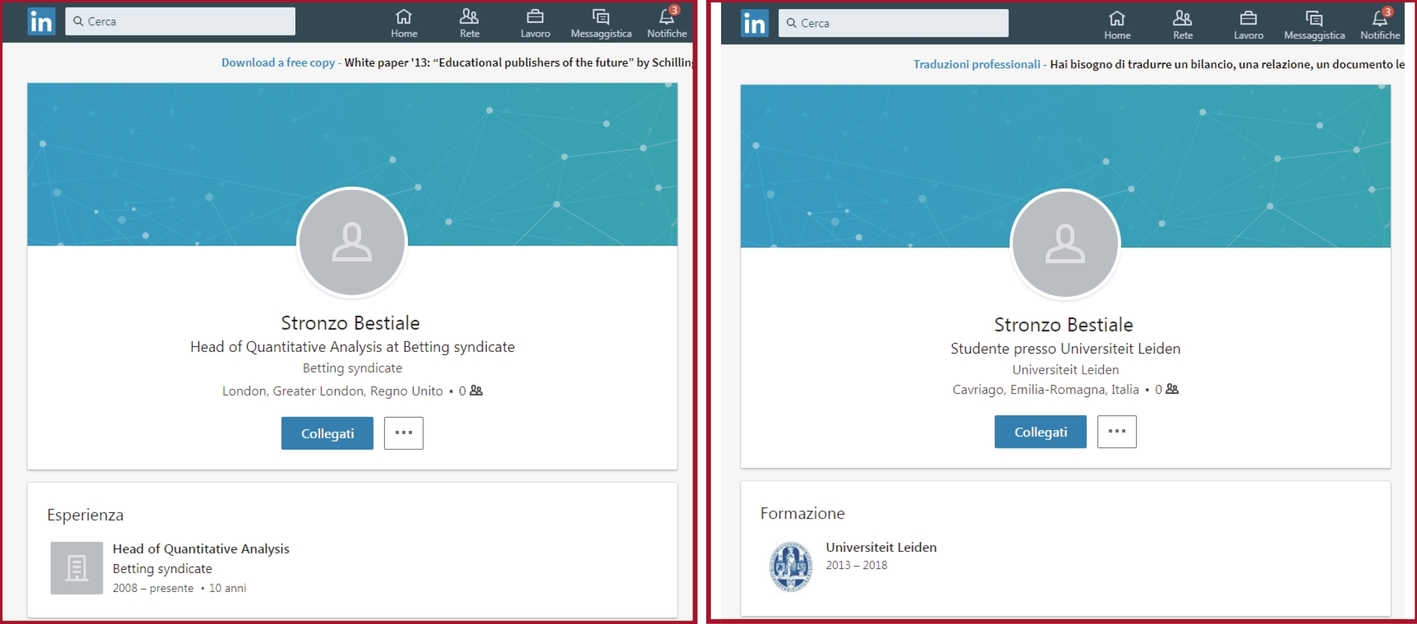 UPDATE #11: two false profiles of Stronzo Bestiale have been published on Linkedin: one is the “head of quantitative analysis” at a London betting syndicate, the other is a self-styled student from Romagna (Italy) at the University of Leiden. Both have no follower: but their existence testifies that the myth of prof. Bestiale remains alive … even in the professional field!
UPDATE #11: two false profiles of Stronzo Bestiale have been published on Linkedin: one is the “head of quantitative analysis” at a London betting syndicate, the other is a self-styled student from Romagna (Italy) at the University of Leiden. Both have no follower: but their existence testifies that the myth of prof. Bestiale remains alive … even in the professional field!
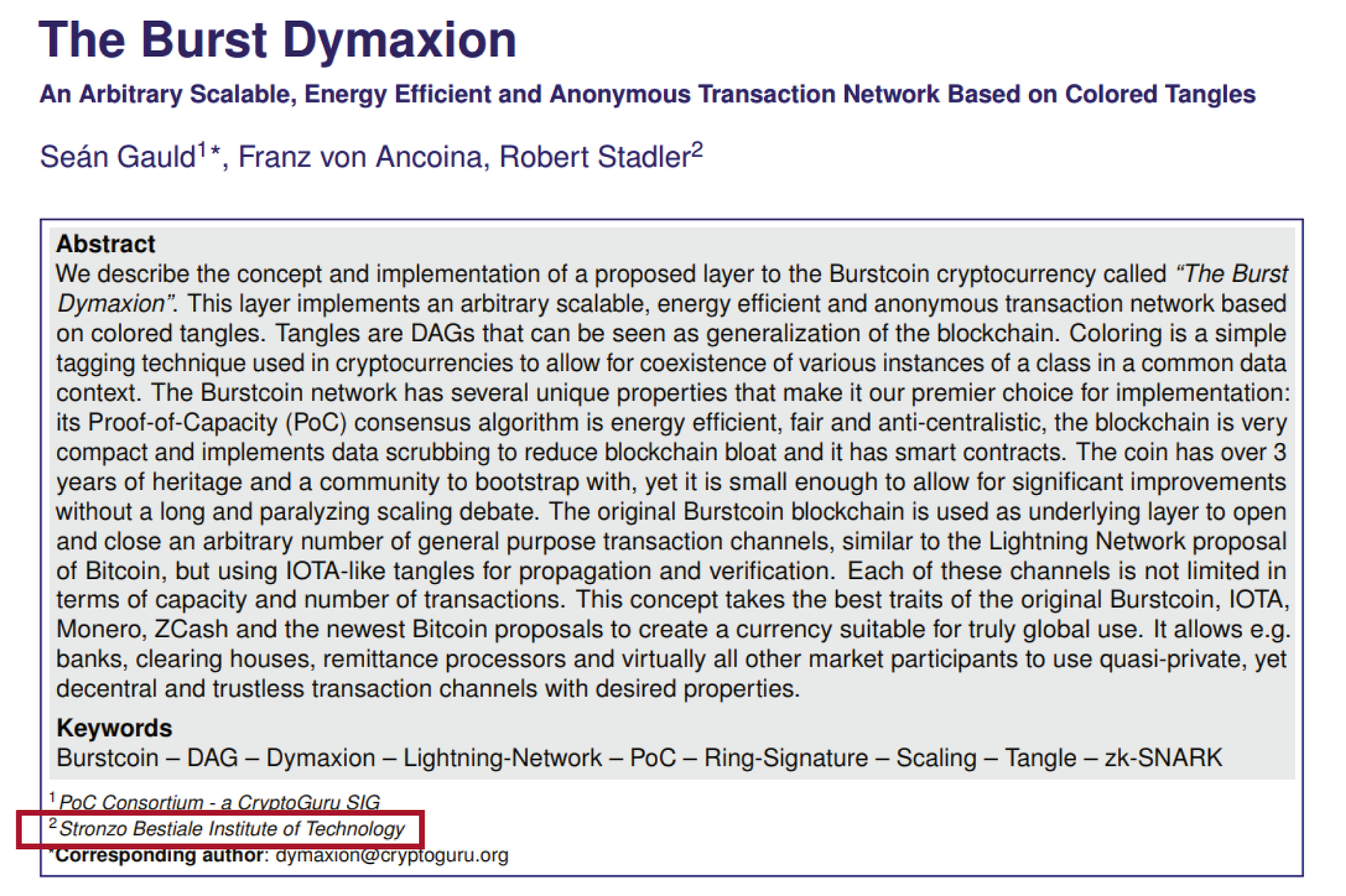 UPDATE #12: Stronzo Bestiale reappeared in a new research published in 2017 on the burst-coin.org website. It’s called “The burst Dymaxion” and talks about cryptocurrencies. Among the authors there is a certain Robert Stadler, who qualifies as a member of the Stronzo Bestiale Institute of Technology, obviously non-existent. And Stadler is also likely to be a pseudonym, given that on the Web the only Stadler that is mentioned is an Austrian designer who has nothing to do with cryptocurrencies. In short, a fake name of a very false institution: among researchers dealing with digital currencies, anonymity is quite common. And in this case there is a note of mocking. [thanks to the biologist Claudio Tiecher who reported it].
UPDATE #12: Stronzo Bestiale reappeared in a new research published in 2017 on the burst-coin.org website. It’s called “The burst Dymaxion” and talks about cryptocurrencies. Among the authors there is a certain Robert Stadler, who qualifies as a member of the Stronzo Bestiale Institute of Technology, obviously non-existent. And Stadler is also likely to be a pseudonym, given that on the Web the only Stadler that is mentioned is an Austrian designer who has nothing to do with cryptocurrencies. In short, a fake name of a very false institution: among researchers dealing with digital currencies, anonymity is quite common. And in this case there is a note of mocking. [thanks to the biologist Claudio Tiecher who reported it].
UPDATE #13
: the story of Stronzo Bestiale has been cited on 3 papers dedicated to the “dark side” of science, or to errors or frauds (or jokes, as in this case) that can be conveyed through scientific papers, despite the referee checks. The first study is by Ernesto Carafoli, of the Institute of Molecular Medicine of Padua, and it is intitled “Scientific misconduct: the dark side of science” (2015). The second is by Marta Brunelli, from the Department of Educational Sciences at the University of Macerata, and it is intitled “To peer review or not to peer review? Ovvero: come sopravvivere alle procedure di referaggio” (2015). The third is a study by Samuel Moore et al. (Kings College, London) entitled: “Excellence R Us: university research and the fetishisation of excellence” (2017).
UPDATE #14: a Spanish band, Sin Arreglo, has launched a crowdfunding to finance the recording of a record entitled “Stronzo bestiale”. An explicit tribute to the story told by this blog. The record was published in 2020: “Stronzo bestiale” is also a song (an instrumental one). You can hear it on YouTube.
UPDATE #15: a researcher from CERN in Geneva, Andrea Giammanco, wrote a novel, “Stable charged and massive particles“, which has as its protagonist professor Bestiale (but his name is Sergio). He is the team leader of the tiny group of the Palermo Institute for Advanced Studies. An obvious homage inspired by the story.
Did you like Stronzo Bestiale story? Here you can read a new, true one: dr. Fuck & Fuck, and their patient (a bitch, obvious).
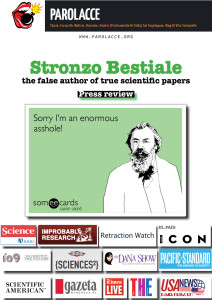 The international Press Review on this story (articles in English, French, Spanish, Portuguese, Greek, Polish, Russian, Chinese, Creole, Italian): → RassegnaStampaStronzoBestiale
The international Press Review on this story (articles in English, French, Spanish, Portuguese, Greek, Polish, Russian, Chinese, Creole, Italian): → RassegnaStampaStronzoBestiale
[ audio ] CHILE, radio Cooperativa (14/10/2014):
Todo es Cierto: Los artículos científicos de Stronzo Bestiale
En Lo que Queda del Día de Cooperativa Paula Molina conversó con el dramaturgo Andrés Kalawski, quien habló sobre los documentos científicos de Stronzo Bestiale y sus coautores.
 [ audio ] BBC radio 4, Inside Science (6/11/2014): from minute 21
[ audio ] BBC radio 4, Inside Science (6/11/2014): from minute 21
Thanks to Sara Scharf for the precious help in reviewing my translation.
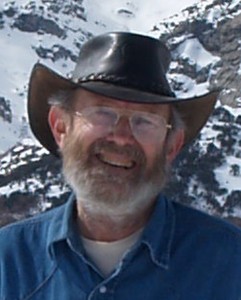
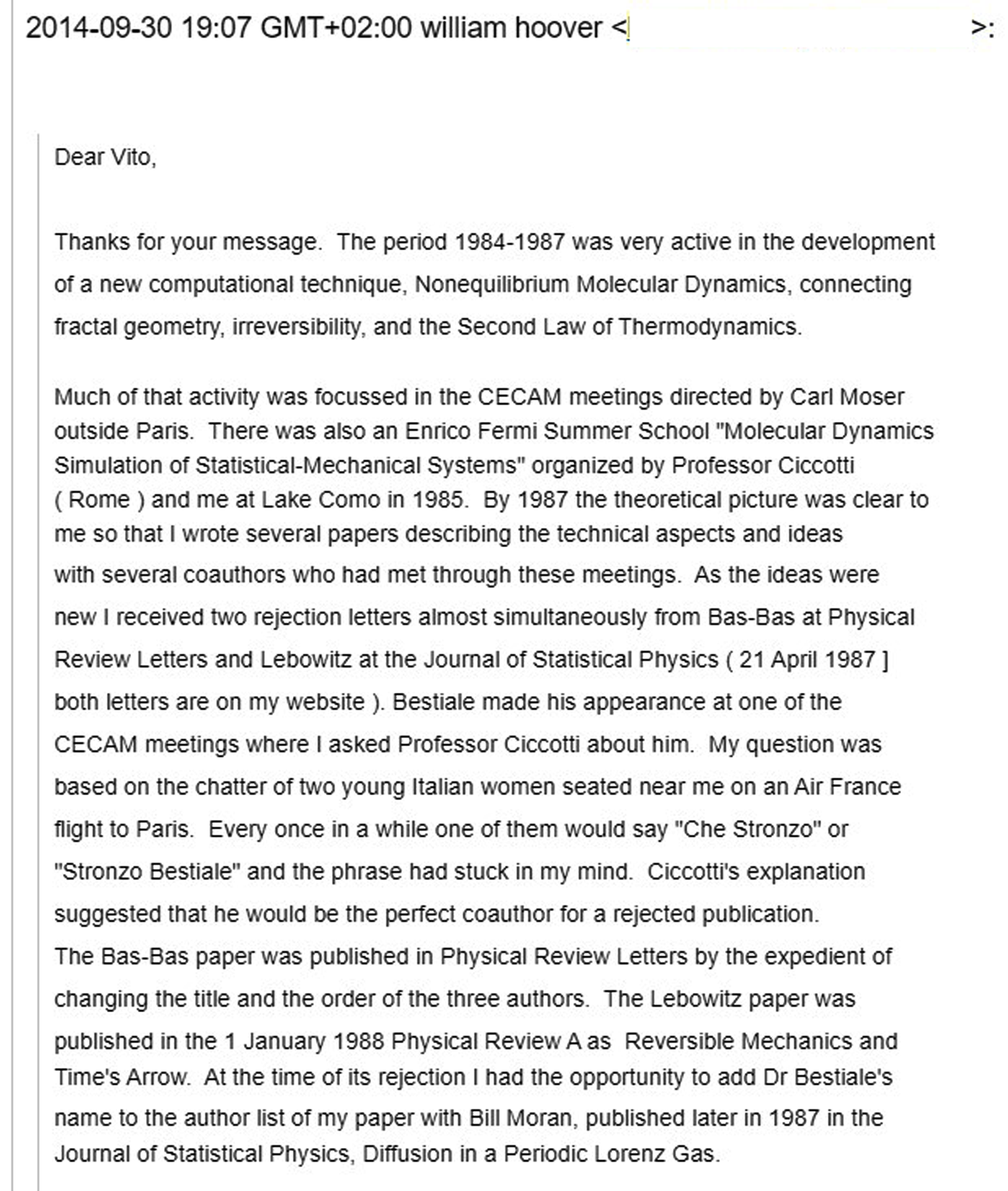

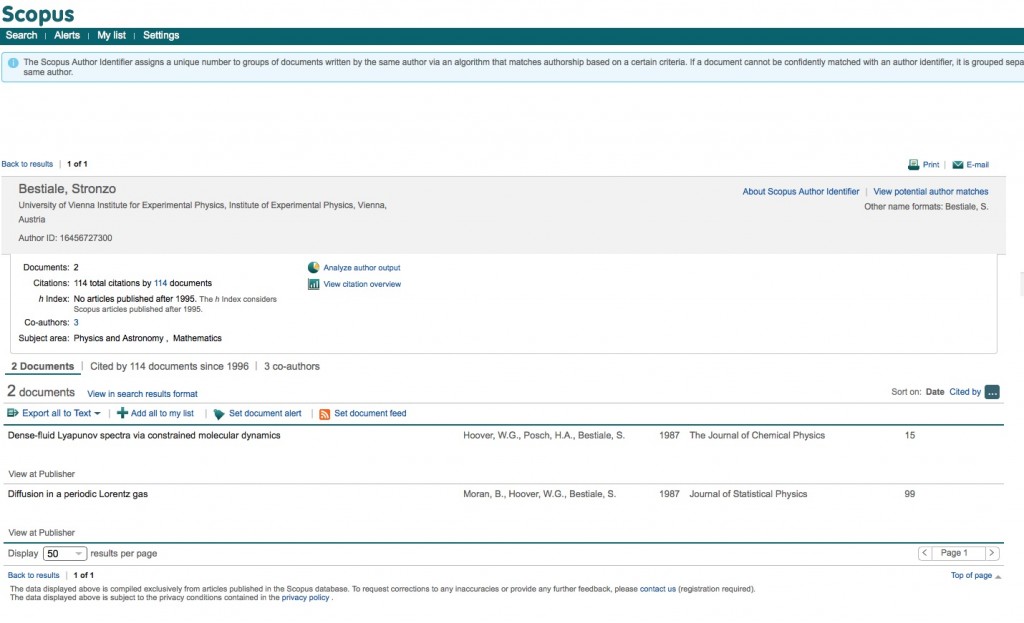
I would add to the story another strange case in scientific publishing. I don’t know why but the symbol for a long “-” in the Web Of Science search engine is often substitued bye the phrase “Symbol of the Klingon Empire” with very funny results like: “Effect of reaction conditions on supercritical hexanes mediated higher alcohol synthesis over a Cu Symbol of the Klingon Empire Co Symbol of the Klingon Empire Zn catalyst”
what about this nobel prize winner article co-author?
http://www.sciencedirect.com/science/article/pii/S0921452600007535
The acronyms in this Chem. Commun. paper—used as shorthand for Bismuth nano-tubes and Copper nano-tubes—have caused much amusement to English speakers over the last 7 years.
http://pubs.rsc.org/en/Content/ArticleLanding/2007/CC/b614147a#!divAbstract
For non-native speakers, the words are define here:
http://en.wiktionary.org/wiki/bint
http://en.wiktionary.org/wiki/cunt
Copper Nitrate is often abbreviated to CuNT in many papers. I’m sure the alternate meaning has not escaped the attention of the authors.
http://en.wikipedia.org/wiki/Cox%E2%80%93Zucker_machine
not as explicit, but still funny:
http://en.wikipedia.org/wiki/Cox-Zucker_machine
I would like to add the story of Professor Massimo Della Serietà:
“The “Sbudella method” a new, effective way to treat people with hole on the stomach.
M. Della Serietà, A. Salsiccia, I. Melone, L.A. Frittata. R. Siffredi Foundation, Italy”
http://medbunker.blogspot.it/2013/02/giornalismo-cancro-e-bufale-il-caso-del.html
Here is a two word abstract. http://iopscience.iop.org/1751-8121/44/49/492001/pdf/1751-8121_44_49_492001.pdf
this is awesome
Awesome but not particularly original. I think this is the source.
http://link.springer.com/article/10.1007%2FBF01218452
Here is a source of significant shock for slavic-speaking chemists (came out back in 2008):
http://www.ncbi.nlm.nih.gov/pubmed/18280775
I study state and non-state armed groups. My favorite group acronym of all time is the Moro Islamic Liberation Front, a religious separatist insurgency in the Phillippines. For the English slang meaning of the acronym, see http://en.wikipedia.org/wiki/MILF
A Swedish university publishes their Central Reports on Sociology in an online repository. The path to the reports, chosen by some engineer, was CRAP (“Report” in Swedish = “Rapport”). I called the head of the department to inform him that this is perhaps a mean joke, but he didn’t get what I was saying at all. After trying 3 different ways to get him to understand, I gave up. CRAP indeed.
Great article! I gave a talk on Australian radio about Humour in Science (http://www.abc.net.au/radionational/programs/ockhamsrazor/humour-in-science/3919798) in which I adduced many more examples. I would be pleased to hear of more still, since I am building up a collection.
Dr Len Fisher, FRSC, FRACI, FInstP, FLS
Visiting Research Fellow
School of Physics
University of Bristol
UK
http://www.lenfisherscience.com
@LenFisherScienc
There’s also the famous (although not offensive) case of the Alpher-Bethe-Gamow paper. In 1948 two Russian physicists, Alpher and Gamow wrote a paper about the Big Bang nucleosynthesis. Gamow added Bethe (a famous theoretical physicist) as the second author just so their names would resemble the first three letters of the Greek alphabet.
http://en.wikipedia.org/wiki/Alpher%E2%80%93Bethe%E2%80%93Gamow_paper
Funny T-Shirt about Stronzo Bestiale here: http://www.redbubble.com/people/mdelfs/works/12811815-hilarious-im-friends-with-stronzo-bestiale-science-paper-joke-t-shirt
There also is the illustrious physicist Kabelschacht (which means cable funnel in German).
https://inspirehep.net/search?ln=de&p=find+a+kabelschacht&of=hb&action_search=Suchen&sf=earliestdate&so=d
How about the journal abbreviation “Anal Chem”? Those chemists do have a wicked sense of humor (or they are really ‘anal’, I suppose)
There is also the paper by Hetherington and Willard on exchange effects in liquid helium-3. Willard was Hetherington’s cat. Supposedly Hetherington was all set to submit his single-author manuscript when a colleague told him that Phys Rev Lett would frown on his use of “we”, so he added his cat as co-author.
There is always a lot of fun when bringing up the “Proceedings of the National Academy of Sciences (PNAS)” in talks.
for all the NMR specialists here:
http://en.wikipedia.org/wiki/Proton-enhanced_nuclear_induction_spectroscopy
The Faggin-Nazzi alphabet is an orthographic system proposed to write the Friulian language, named after its creators, Gianni Nazzi and Giorgio Faggin.
http://en.wikipedia.org/wiki/Faggin-Nazzi_alphabet
I guess you might be interested in a Cox-Zuker Machine?
http://projecteuclid.org/euclid.nmj/1118787426
You might be interested in searching for the CRAPOLA model of “non-sequential ionisation of multi-electron atoms”
Nucleotide sequence analysis of the accessory genes of HIV-1 groupO isolates
Alejandro Vallejo a,*, Lutz Gurtler b, Leopold Zekeng c, Indira K. Hewlett
Acknowledgements:
We thank Dr Lucas Grijander for his valuable comments.
Lucas Grijander was a character created by humorist Florentino Fernandez.
Not the same thing because these are real authors, but the names of the creators of the first artificial neural network, McCulloch and Pitts, in the Catalan language sound like ass (cul) and boobs (pits).
Thanks for this, hadn’t heard of this one before! I think you will love the folowing:
– Funny acknowledgments in academic papers: http://www.academiaobscura.com/we-gratefully-acknowledge/
– Animal authors: http://www.academiaobscura.com/academic-animals/
– Posthumous publishing: http://www.academiaobscura.com/the-last-writes-posthumous-publishing/
– Amusing co-authoring stories: http://www.academiaobscura.com/co-authoring/
What about this one:
Sergei Saccadoviç, in the acknowledgments of a paper about saccades….. They planned to have him co-author and first-author a paper as well, but backed out of it in the end. Still fun.
http://www.sciencedirect.com/science/article/pii/S004269890000184X
Anybody ever heard about the **NeuroAssess** glove?
I wonder what would be the proper way to use it…
http://www.biomedcentral.com/content/pdf/1743-0003-9-2.pdf
Astronomy has a similar tradition with a fictitious character named J.J. Charfman. His first paper is here: http://adsabs.harvard.edu/abs/1980IAUS…87..645C
During the postgrad work I encountered the following paper:
http://citeseerx.ist.psu.edu/viewdoc/summary?doi=10.1.1.305.4201
This was a seminal paper in the field, I knew one of the authors, and had seen much work by another, but the last, “T.I.A Fudge”, had seemingly never published anything else. This surprised me, given the import of the work, so I chased down the author I knew and asked him about this mystery contributor. Turned out, They had a really sound theory, except for a constant factor they couldn’t account for (at the time – they subsequently were able to refine the theory). To explain this in the short term they brought in the Fudge Factor, accredited to TIA, better known as “This Is A”. Hence “This Is A Fudge” is the third author, who never reappeared formally – though often informally – in academia.
The recent article “Contribution to the knowledge of Afrotropical Rutelinae III” by P. Limbourg [Belgian Journal of Entomology 17 : 1-33 (2014)] gives the name “adoretus constanti” to a new species, remarking that this name is “dedicated to my fucking bastard colleague Jérôme Constant”. I would be curious to find out why…
I would submit the paper
“W.H. Knox, R.S. Knox, J.F. Hoose and R.N. Zare, “Observation of the 0 fs pulse” Optics and Photonics News, April 1, 1990,”
Which is mostly comedic, but is written as if it were not and has all real authors.
Just to add that Merda means shit in portuguese too (not only Catalan and Italian).
Astronomers tends to be more visual…
Check out these plots from published papers:
http://amandabauer.blogspot.com.au/2010/03/dirty-space-news.html
dirty space…. simply fantastic!!!!!
Entirely real people and no joke intended, but I like to think they planned the author order: “Low, N., Butt, S., Paine, A.E., and J.D. Smith. 2007. Helping Out: A national survey of volunteering and charitable giving. London: Institute for Volunteering Research.” http://www.ivr.org.uk/component/ivr/helping-out-a-national-survey-of-volunteering-and-charitable-giving
The best graphical abstract ever: http://pubs.acs.org/doi/abs/10.1021/ic0352250
A perfect molecular synthesis!!!! :-)))))
There is also the famous “fuck fuck bitch”, which, if typed into pubmed, reveals a paper with two authors named “Fuck” and a paper title contained the word “bitch”…
Reminds me of a story back in 1999 in the north of France. A city wanted to change the name of its “rue Gay-Lussac”, because some company was claiming that the word Gay in its address was harming its business.
If you can read french:
http://tetu.yagg.com/1999/02/27/micmac-a-villeneuve-dascq-autour-de-la-rue-gay-lussac/
http://www.liberation.fr/societe/1999/02/27/une-histoire-gay-lussac-retrouve-pignon-sur-rue_266108
As someone with a real anatomical name–but one distorted by immigration officials in the 1800s, I can sympathize with those whose names have taken on vulgar meanings. This was also the case about a decase ago when suburban Philadelphia’s Beaver College changed its name to Acadia University. Originally, it was located in Beaver County, Pennsylvania.h
I’ve had my own go at compiling humorous author names in a mock paper. http://conservationbytes.com/2010/10/11/the-importance-of-being-serious-in-science/
In astrophysics, there’s the very real — inevitable, one might say! — coauthorship of D’Eath and Payne.
And let’s not forget the ARSE gene.